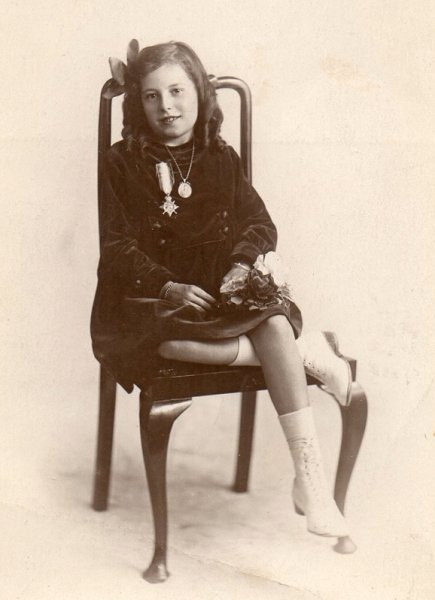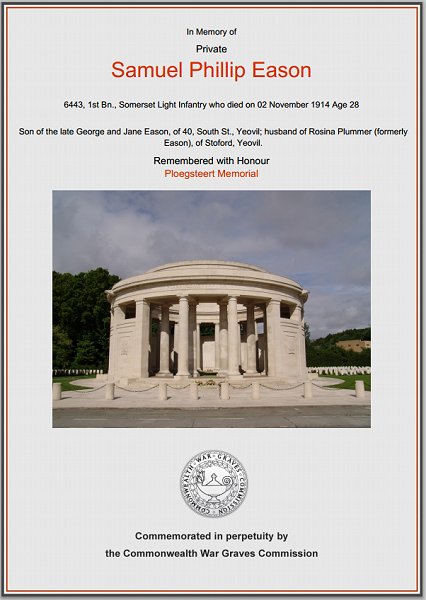yeovil at War
Samuel phillip Eason
Killed on the last day of the Battle of Messines
Samuel Phillip Eason was born in Yeovil Marsh in 1886, the son of agricultural labourer George Eason of Mudford Sock and his wife Jane. In the 1891 census George and Jane were living at Mudford Sock with their family that included seven-year-old Kate Riggs (George's illegitimate daughter) as well as George and Jane's children Samuel aged six, Anna aged four, Walter aged one and Edwin just a few weeks old. By the time of the 1901 census George Eason had died and Jane had moved into Yeovil with her family. The census recorded them living at 41 South Street; Jane, a widow aged 39 was working as a charwoman and Samuel, now aged 16, was working as a blacksmith. Also living with them were Walter and Edwin as well as a new daughter, seven-year-old Florence.
In April 1909, at the age of 24, Samuel married Rosina Sams (1885-1968) in Yeovil. They were to have one daughter, Violet (1910-1988) and another child who died in infancy. Samuel and Rosina set up home at Stoford, just south of Yeovil and in the 1911 census Samuel listed his occupation as a railway labourer.
 It
is not known
when Samuel
enlisted in the
Army by he
joined the
Regular 1st
Battalion,
Somerset Light
Infantry at
Yeovil probably
shortly after
the start of the
First World War.
At the outbreak
of war in 1914
the 1st
Battalion was in
Colchester, with
11th Brigade,
4th Division.
It
is not known
when Samuel
enlisted in the
Army by he
joined the
Regular 1st
Battalion,
Somerset Light
Infantry at
Yeovil probably
shortly after
the start of the
First World War.
At the outbreak
of war in 1914
the 1st
Battalion was in
Colchester, with
11th Brigade,
4th Division.
The Battalion landed at Le Havre, France with the British Expeditionary Force (BEF) on 22 August 1914, in time to fight in the battle of Le Cateau during the retreat from Mons. In 1914 the 1st Battalion saw action at the Battle of the Marne, the Battle of the Aisne and at the Battle of Messines.
The First Battle of the Marne, fought from 5 to 12 September 1914, resulted in an Allied victory against the German Army. The battle was the culmination of the German advance into France and pursuit of the Allied armies which followed the Battle of the Frontiers in August, which had reached the outskirts of Paris.
The counterattack of six French field armies and the British Expeditionary Force (BEF) along the Marne River forced the German Imperial Army to abandon its push on Paris and retreat north-east, leading to the 'Race to the Sea' and setting the stage for four years of trench warfare on the Western Front. The Battle of the Marne was an immense strategic victory for the Allies, wrecking Germany's bid for a swift victory over France and forcing it into a drawn-out two-front war.
The First Battle of the Aisne was the Allied follow-up offensive against the right wing of the German First and Second Armies as they retreated after the First Battle of the Marne earlier in September 1914. The offensive began on the evening of 13 September, after a hasty pursuit of the Germans. When the Germans turned to face the pursuing Allies on 13 September, they held one of the most formidable positions on the Western Front. Low crops in the unfenced countryside offered no natural concealment to the Allies but deep, narrow paths cut into the escarpment at right angles, exposing any infiltrators to extreme hazard. In dense fog on the night of 13 September, most of the BEF crossed the Aisne on pontoons or partially demolished bridges. Under the thick cover of the foggy night, the BEF advanced up the narrow paths to the plateau. When the mist evaporated under a bright morning sun, they were mercilessly raked by fire from the flank. Those caught in the valley without the fog's protective shroud fared no better. It soon became clear that neither side could budge the other and since neither chose to retreat, the impasse hardened into stalemate that would lock the antagonists into a relatively narrow strip for the next four years.
The Battle of Messines, fought between 12 October and 2 November 1914, was part of the 'Race to the Sea', the series of battles that decided the line of the Western Front. In the aftermath of the first Battle of the Marne, it was decided to move the BEF back north to Flanders, to shorten its supply lines back to the channel ports. The Battle of Messines was the official name for the fighting between the river Douve and the Comines-Ypres canal, but it merged into the battle of Armentières to the south and the first battle of Ypres to the north. After the heavy fighting of 1 November the Somersets were relocated to a new position. The Regimental History of the Somerset Light Infantry outlined events of 2 November 1914 - "The new position held by the Somersets was no sinecure. It faced east, north-east and north, and was therefore, in fact, open to enfilade fire. This became apparent during the 2nd November, when both H and A Companies' trenches were heavily shelled by hostile heavy guns, one of the former and two of the latter companies' trenches being enfiladed from the east.... Although the Battalion Diary records that "Both this Battalion and the Hants suffered very heavily" no other details of casualties are given." Nevertheless it was in this position occupied by the Battalion that Private Samuel Eason was killed in action that day. He was aged 28.
Samuel Eason is commemorated on Panel 3, Ploegsteert Memorial, Hainaut, Belgium. A note on the Yeovil Town website reads "Samuel Eason had one daughter but as Samuel was reported missing presumed killed, his mother would never accept his death and refused to have his name inscribed on the Yeovil War Memorial. However, in September 1989, Mrs Evans, of Bridport called at the offices of South Somerset District Council to enquire whether Samuel’s name could be added to the Memorial because her mother, Samuel’s daughter, would dearly like to see her father’s sacrifice commemorated in his native town. This was agreed and his name has been added. Samuel’s widow was living in Stoford at the time of her husband’s death and his name has been included on the Barwick and Stoford Memorial in Barwick Church."

Samuel's daughter Violet, about 1920, wearing her late father's medal (either a 1914 Star or a 1914-15 Star) as well as a necklace pendant with his photograph.
gallery

The Commonwealth War Graves Commission certificate in memory of Samuel Eason.
(Note - Rosina remarried in Salisbury in 1917)